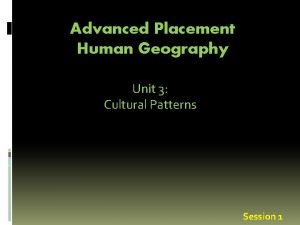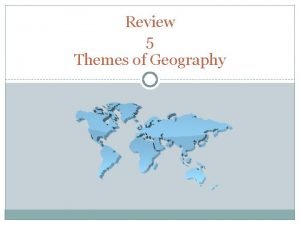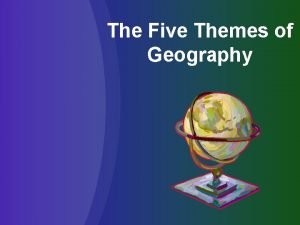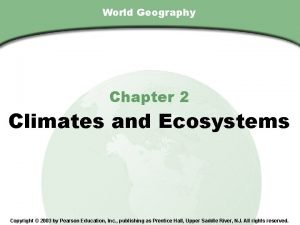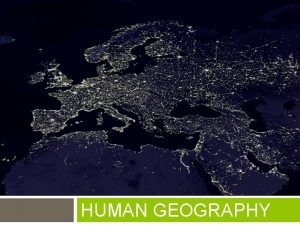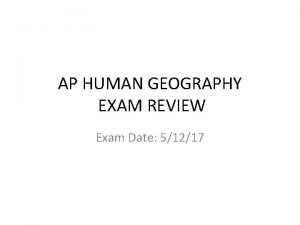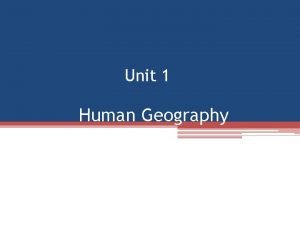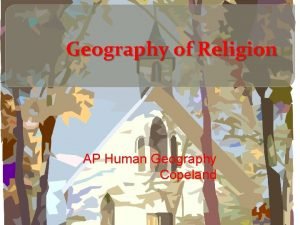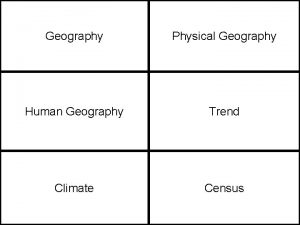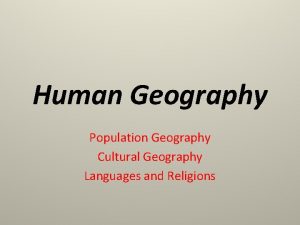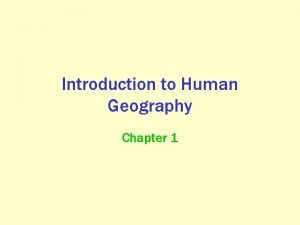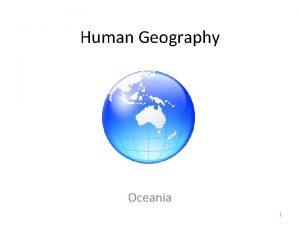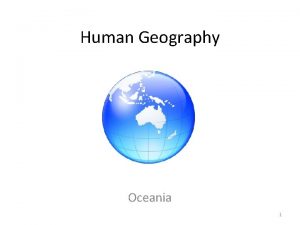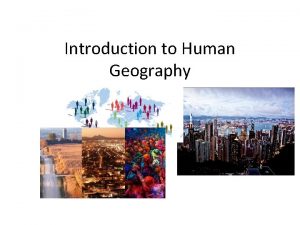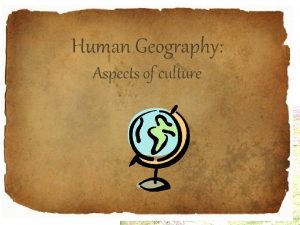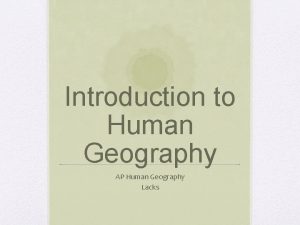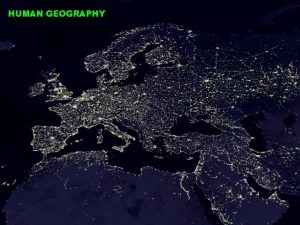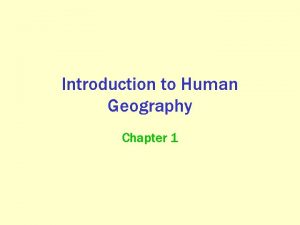AP HUMAN GEOGRAPHY EXAM REVIEW The AP Exam

































- Slides: 33

AP HUMAN GEOGRAPHY EXAM REVIEW

The AP Exam 2 hrs, 15 mins Section 1: MCQs � 60 minutes � 75 questions Section 2: FRQs � 75 minutes � 3 questions 50% MCQ 50% FRQ

Section 1: Multiple Choice Tips Scores are based how many you get right No points are deducted for wrong answers So ANSWER EVERY QUESTION- don’t leave any blank!

Section 1: Multiple Choice Tips Read carefully! Eliminate as many answer choices as possible

Section 2: Free Response Questions You have 75 minutes to answer all 3 questions You should spend 25 minutes on each Read the question carefully before you answer.

Section 2: Free Response Questions You must write in complete sentences, but it does not need to be a formal essay. If you are given three parts to a question (A, B, C…) organize your answers in the same way You may NOT bullet your answers… even if they ask to “list”. If asked to list one and you list two, the second will not be graded. So develop first point.

Practice FRQ: 2010

The population pyramids above represent two countries at different stages of the demographic transition and economic development. Part A (2 points) Explain the demographic characteristics of each country above with respect to the demographic transition model. • Must mention Stage 2 (second or early expanding stage) AND elaborate briefly about its characteristics, such as high birth rate, falling death rate, youthful population, developing country. Country A • It is not acceptable to suggest Stages 1 or 3 for Country A. • Must mention Stage 4 (fourth, final, or low stationary stage) AND elaborate briefly about its characteristics, such as low birth rate, low death rate, aging population, developed country. Country B • It is acceptable to mention a possible Stage 5 (fifth stage) for Country B.

Part B (2 points) Discuss ONE positive impact of EACH country’s population structure on its economic development. Country A • Expanding or large workforce (1 point) • Youthful population, which can spark creativity, receptivity to change, etc. • Less need for immigrant labor • Less need for elder social safety net (e. g. , Social Security) Country B • Educated (skilled, experienced, etc. ) workforce (1 point) • Low youth dependency ratio • More women in the compensated workforce • Tendency to spend discretionary income on needs other than education • Might need immigrant labor, which would allow citizens to take higher-order jobs

Part C (2 points) Discuss ONE negative impact of EACH country’s population structure on its economic development. Country A • High youth dependency ratio (1 point) • Strain on resources, the environment or society owing to rapid population growth • Low literacy rate for women • Fewer women in the compensated workforce Country B • High elder dependency ratio (1 point) • Possible future labor shortage • Greater need to fund elder social safety net (e. g. , Social Security)

Exam Scores 5 • Extremely Well Qualified • = an A in college 4 • Well Qualified • = a B in college 3 • Qualified • = a C in college • Possibly Qualified • =a. D 2 1 • No recommendation

www. collegeboard. org

UNIT 1 GEOGRAPHY: ITS NATURE AND PERSPECTIVES 5 -10% of the AP Exam

The 5 Themes Location Place Human/Environment Interaction Movement Regions

The 5 Themes Location � Absolute � Relative Place Human/Environment Interaction Movement Regions

The 5 Themes Location Place � Toponyms- place names � Site- location based on characteristics � Situation- relative location Human/Environment Interaction Movement Regions

The 5 Themes Location Place Human/Environment Interaction Movement � Migration � Communication, Regions transportation, trade

The 5 Themes Location Place Human/Environment Interaction Movement Regions � Formal � Functional � Perceptual

Scale • • Small scale = small detail Large scale= large detail

Large-scale Small-scale

Important lines of latitude Equator: Equator 0 degrees Tropic of Cancer: 23. 5 degrees North Tropic of Capricorn: 23. 5 degrees South Arctic Circle: 66. 5 degrees North Antarctic Circle: 66. 5 degrees South Parallels are circular lines used to indicate latitude

important lines of longitude Prime Meridian: Meridian 0 degrees (runs through Greenwich, England) International Dateline: Dateline 180 degrees Time Zones: Zones every 15 degrees of longitude equals


Time Zones http: //www. timezonecheck. com/ http: //www. bbc. co. uk/news/world

Geographic Information System: a collection of computer hardware and software that permits storage and analysis of layers of spatial data.

Space-Time Compression, 1492 -1962 The times required to cross the Atlantic, or orbit the earth, illustrate how transport improvements have shrunk the world.

When contact diminishes with increasing distance and eventually disappears. Distance Decay

Thematic Maps Dot Map Contour or Isoline map Cartogram map Proportional symbol map Cloropleth map Flow line

World Population Cartogram

Space: Distribution of Features Spatial Distribution—The regular arrangement of a phenomenon across Earth’s surface. Three features � (1)Density � (2)Concentration � (3)Pattern

Diffusion • The process by which a characteristic spreads across space and over time • Hearth = source area for innovations • There are two main types of diffusion – – (1)Relocation (2)Expansion

The Cultural Landscape A unique combination of social relationships and physical processes Each region = a distinctive landscape People = the most important agents of change to Earth’s surface

 Frq ap human geography format
Frq ap human geography format 5 themes of geography ap human geography
5 themes of geography ap human geography Stateless nation
Stateless nation Distance decay ap human geography
Distance decay ap human geography Writ of certiorari ap gov example
Writ of certiorari ap gov example Human development index definition ap human geography
Human development index definition ap human geography Pltw human body systems final exam review
Pltw human body systems final exam review World history and geography final exam study guide
World history and geography final exam study guide Taj mahal relative location
Taj mahal relative location 5 themes of geography review game
5 themes of geography review game World geography chapter 2 review answers
World geography chapter 2 review answers Hát kết hợp bộ gõ cơ thể
Hát kết hợp bộ gõ cơ thể Bổ thể
Bổ thể Tỉ lệ cơ thể trẻ em
Tỉ lệ cơ thể trẻ em Chó sói
Chó sói Tư thế worms-breton
Tư thế worms-breton Hát lên người ơi
Hát lên người ơi Môn thể thao bắt đầu bằng từ đua
Môn thể thao bắt đầu bằng từ đua Thế nào là hệ số cao nhất
Thế nào là hệ số cao nhất Các châu lục và đại dương trên thế giới
Các châu lục và đại dương trên thế giới Công của trọng lực
Công của trọng lực Trời xanh đây là của chúng ta thể thơ
Trời xanh đây là của chúng ta thể thơ Cách giải mật thư tọa độ
Cách giải mật thư tọa độ Phép trừ bù
Phép trừ bù độ dài liên kết
độ dài liên kết Các châu lục và đại dương trên thế giới
Các châu lục và đại dương trên thế giới Thể thơ truyền thống
Thể thơ truyền thống Quá trình desamine hóa có thể tạo ra
Quá trình desamine hóa có thể tạo ra Một số thể thơ truyền thống
Một số thể thơ truyền thống Cái miệng bé xinh thế chỉ nói điều hay thôi
Cái miệng bé xinh thế chỉ nói điều hay thôi Vẽ hình chiếu vuông góc của vật thể sau
Vẽ hình chiếu vuông góc của vật thể sau Thế nào là sự mỏi cơ
Thế nào là sự mỏi cơ đặc điểm cơ thể của người tối cổ
đặc điểm cơ thể của người tối cổ



